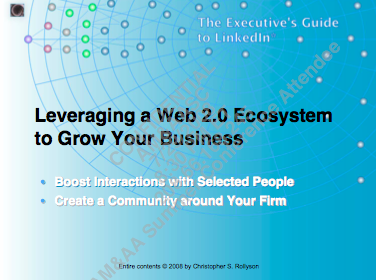Web 2.0 and the Mergers and Acquisitions Industry at the AM&AA reveals how digital social networks are affecting mergers and acquisitions in the mid-market
Reports of “Character Building” Market—Significant Parallels with High Tech Bust—Plus, the Emerging Web 2.0 Vein
 The sub-prime induced correction of the U.S. financial sector has changed the context around M&A during the last year, and mergers and acquisitions experts met last week to share success stories, lessons learned and admonitions at the Alliance of Mergers & Acquisition Advisors Summer Conference July 22-25, 2008 at Chicago’s Wyndham Hotel. I was asked to present a new talk, “Leveraging a Web 2.0 Ecosystem to Grow Your Business,” and I had the opportunity to attend some of the other sessions. I’ll summarize their key points before adding some thoughts on the promise that Web 2.0 and social networks bring to deal marketing due to significantly decreased transaction costs.
The sub-prime induced correction of the U.S. financial sector has changed the context around M&A during the last year, and mergers and acquisitions experts met last week to share success stories, lessons learned and admonitions at the Alliance of Mergers & Acquisition Advisors Summer Conference July 22-25, 2008 at Chicago’s Wyndham Hotel. I was asked to present a new talk, “Leveraging a Web 2.0 Ecosystem to Grow Your Business,” and I had the opportunity to attend some of the other sessions. I’ll summarize their key points before adding some thoughts on the promise that Web 2.0 and social networks bring to deal marketing due to significantly decreased transaction costs.
AM&AA members hail from all parts of a rich ecosystem of investment bankers, attorneys, private equity, brokers, intermediaries, CPAs and others who specialize in every aspect of architecting, researching, negotiating and executing deals. To make money consistently in M&A, one needs to know how to identify and manage a wide range of risks. The financial system’s painful correction is changing many of the metrics around M&A, but those who can adjust their strategies can do quite well. It’s necessary to accept the new conditions and to play by them.
As I listened to speakers briefing the audience on “the new reality,” I kept having flashbacks to the Web 1.0 tech bust: flight to quality, increased due diligence, firms having money but not spending it, intermediaries’ difficulty in changing sellers’ expectations. AM&AA members specialize in U.S.-based manufacturing, and their sources of funding aren’t VCs but investment banks and private equity firms. But they’re essentially in the same business: risk management and relationships. Managing exogenous shocks to their ecosystems.
Highlights
These from presentations by Andy Greenberg of GF Data Resources, Bill Spizman of RSM McGladrey, Scott Lutzke of Centerfield Capital, the private equity panel (Michael Pfeffer of Post Capital, Chip Grace of Wynnchurch Capital, John Higgins of Huron Capital, Eric Kutsenda of Seidler Equity Partners, moderated by Jim Hill of Benesch Attorneys), Robert Hogan of Code Hennessy, Luke Phenicie of Hammond Kennedy Whitney, Mike Conaton of Key Principal Partners, Tim Rhine of Corporate Capital, Dan Bradbury of V-Rooms, and Joe Rippe of Rippe & Kingston.
- Conditions are currently in a holding pattern, and deals requiring leverage (extensive funding) are the most affected by the credit squeeze, especially with regional banking partners (the ones currently eating away at the FDIC fund)
- Unfavorable trends in the market: CPG (consumer-oriented), oil/transportation-focused, mortgage-dependent and highly leveraged
- Favorable trends in the market: capital is available, borrowing costs are low (Federal Reserve cuts), favorable exchange rates (U.S. focused audience), significant government support (mortgages)
- Lines of credit are being pulled from certain companies and banks
- Strategic buyers always emerge in a down economy, when prices are lower
- Expect foreign buyers to play an increasing role in deals due to the lower U.S. Dollar
- Buyers are doing much more thorough due diligence, so expect this and prepare for it
- Down markets increase the portion of deals that fail after the letter of intent; sellers are more likely to misrepresent some aspect of their companies
- Due diligence is far more rigorous than financial audits
- On smaller deals, don’t insist on GAAP; remember, as the seller, you are partnering with the purchased company’s management team, so focus on the relationship
- While subprime mortgage portfolios do affect available capital, more significant for middle market M&A is the deterioration of banks’ corporate loan portfolios
- Leveraged loan volume in the upper middle market fell to a four-year low in Q1 2008, down 67% from 2007
- Supply and demand for commercial and industrial loans looks very similar to 2001 measures
- The market is bifurcating: large creditworthy companies can get financing at competitive rates, as can small companies with good deals; the middle is tough
- Private equity raised significant funds last year (2000, anyone?), but participation in deals has fallen this year
- Strategic buyers are very important, so seek them out
- Valuations are holding up so far, but they will certainly fall if credit markets deteriorate further
- It adds up to a flight to quality; only really solid deals are being done now, which forces everyone to up their game
- Sellers are starting to listen and lower their expectations (of what they can get for their companies)
- Private equity firms don’t often give credit for “synergies”; the way they look at it, synergies are part of the deal
- One of the most interesting sessions was on working capital; it showed how buyers and sellers could have completely different expectations and definitions, and it’s a leading deal killer; although the definition is easy (current assets – current liabilities) and seems clear enough, there’s a lot of gray. For example, the business needs enough working capital to achieve its future value, clearly open to interpretation
- Industry solutions such as V-Rooms’ electronic deal rooms offer interesting new opportunities to digitize the deal process
- You’ve heard of GAAP.. how about FOAP (Family Owned Accounting Practices ,^)
Tricks Some Companies Use
- “Leaving out” certain expenses in the balance sheet
- Accelerate the backlog to give the appearance of better financial health
- Watch for pricing pressures from customers and vendors (make sure to compare current and projected trends with historical)
- Giving higher sales returns and allowances to maintain sales
- Deferring needed capital expenditures
- Accelerate revenue through aggressive incentives and changing revenue recognition
The Web 2.0 Angle to Mergers & Acquisitions
Web 2.0 and social networks significantly reduce the transaction costs of finding and engaging experts with very specific characteristics (say, a COO with a line engineering background to run a ball bering manufacturer with $250 million in revenue). If there was ever an industry that understands transaction costs, this is it, but the (information) technology context isn’t native for many M&A professionals, so there was a sense of discovery when discussing possibilities. Observations:
 The current leader in executive social networks, LinkedIn, is a (Silicon) Valley company that was designed for start-ups’ management teams to build and cycle their companies faster. That means: locating VCs with certain portfolios and proclivities, attorneys with specific experience, key advisors and employees at inflection points of the start-up’s life cycle. Key marketing, PR and alliance providers. LinkedIn accelerates company life cycles by reducing these transaction costs in terms of speed and specificity: find exactly who you need when you need him/her. The players are slightly different in midmarket manufacturing-oriented M&A, but roles are mirrored.
The current leader in executive social networks, LinkedIn, is a (Silicon) Valley company that was designed for start-ups’ management teams to build and cycle their companies faster. That means: locating VCs with certain portfolios and proclivities, attorneys with specific experience, key advisors and employees at inflection points of the start-up’s life cycle. Key marketing, PR and alliance providers. LinkedIn accelerates company life cycles by reducing these transaction costs in terms of speed and specificity: find exactly who you need when you need him/her. The players are slightly different in midmarket manufacturing-oriented M&A, but roles are mirrored.- The rub is that virtually everyone in the tech start-up ecosystem is on LinkedIn, and manufacturing M&A players lag in adoption; however, adoption is quickening. I am constantly surprised at how many executives from non-tech industries I find in LinkedIn. This trend is accelerating.
- The midmarket M&A community seems to be quite collegial and open; LinkedIn Answers hold significant promise for sourcing key buyers, sellers, operating executives and facilitators. Consider Manufacturing, Supply Chain Management, Mergers & Acquisitions, Venture Capital and Private Equity, Foreign Investment, Corporate Governance, or Risk Management.
- Web 2.0 holds significant promise to improve deal teams’ efficiency. Consider Cisco’s much publicized results.
- Midmarket M&A would have much to gain by going global, and social networks are global by default. See “New from the Unorthodox Exit Strategy Department—Acquisition by an Asian Firm” or “India Trade Minister Draws Chicago-India Transformation Parallels at Executives’ Club” (Analysis and Conclusions).
- The Professional’s Web 2.0 Pyramid presented LinkedIn at the bottom (largest time investment for optimal returns for most firms), followed by blogs, websites and “exotics” (multimedia, consumer-oriented social networks like Facebook and MySpace)
- M&A firms could tap low-hanging fruit by learning key elements of keywords, profile management and advanced search techniques on LinkedIn. This would enable them to be found according to very specific criteria—and to find people better.
- Blogging began with an antiestablishment flavor, as did the Internet. That’s all gone—blogs are mainstream—and firms can blog very conservatively to communicate their thought leadership, values and observations in digestible chunks, while enjoying better search engine attention.
- For more, see “Leveraging a Web 2.0 Ecosystem to Grow Your Business

Leave a Reply
You must be logged in to post a comment.